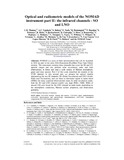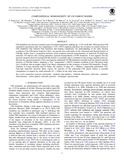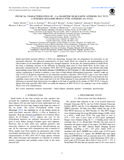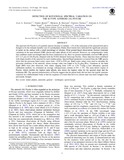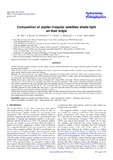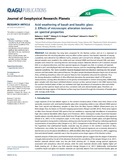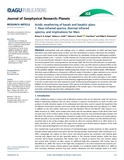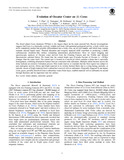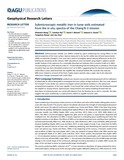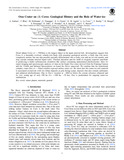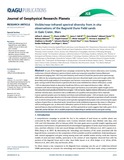Browsing Ed Cloutis by Issue Date
Now showing items 21-31 of 31
-
Optical and radiometric models of the NOMAD instrument part II: the infrared channels - SO and LNO
(Optics Express, 2016-02-16)NOMAD is a suite of three spectrometers that will be launched in 2016 as part of the joint ESA-Roscosmos ExoMars Trace Gas Orbiter mission. The instrument contains three channels that cover the IR and UV spectral ranges ... -
Compositional homogeneity of CM parent bodies.
(The Astronomical Journal, 2016-08-10)CM chondrites are the most common type of hydrated meteorites, making up ∼1.5% of all falls. Whereas most CM chondrites experienced only low-temperature (∼0°C–120°C) aqueous alteration, the existence of a small fraction ... -
Physical characterization of ~2 m diameter near-Earth asteroid 2015 TC25: A possible boulder from E-type asteroid (44) Nysa
(The Astronomical Journal, 2016-11-11)Small near-Earth asteroids (NEAs) (<20 m) are interesting, because they are progenitors for meteorites in our terrestrial collection. The physical characteristics of these small NEAs are crucial to our understanding of the ... -
Detection of rotational spectral variation on the M-type asteroid (16) Psyche
(The Astronomical Journal, 2016-12-28)The asteroid (16) Psyche is of scientific interest because it contains ∼1% of the total mass of the asteroid belt and is thought to be the remnant metallic core of a protoplanet. Radar observations have indicated the ... -
Composition of Jupiter irregular satellites sheds light on their origin
(EDP Sciences, 2017)Context. Irregular satellites of Jupiter with their highly eccentric, inclined and distant orbits suggest that their capture took place after the giant planet migration. Aims. We aim to improve our understanding of the ... -
Acid weathering of basalt and basaltic glass: 2. Effects of microscopic alteration textures on spectral properties
(Journal of Geophysical Research: Planets, 2017-01-24)Acid alteration has long been proposed for the Martian surface, and so it is important to understand how the resulting alteration textures affect surface spectra. Two basaltic materials of varying crystallinity were altered ... -
Acidic weathering of basalt and basaltic glass: 1. Near-infrared spectra, thermal infrared spectra, and implications for Mars
(Journal of Geophysical Research: Planets, 2017-01-24)Acid-leached rinds and coatings occur in volcanic environments on Earth and have been identified using orbital spectroscopy on Mars, but their development is poorly understood. We simulated long-term open-system acidic ... -
Evolution of Occator Crater on (1) Ceres
(The Astronomical Journal, 2017-02-17)The dwarf planet Ceres (diameter 939 km) is the largest object in the main asteroid belt. Recent investigations suggest that Ceres is a thermally evolved, volatile-rich body with potential geological activity, a body which ... -
Submicroscopic metallic iron in lunar soils estimated from the in situ spectra of the Chang’E-3 mission
(Geophysical Research Letters, 2017-04-22)Submicroscopic metallic iron (SMFe) created by space weathering has strong effects on the optical properties of the lunar surface. Spectra measured in situ by the visible-near-infrared spectrometer (VNIS) on board the ... -
Oxo Crater on (1) Ceres: Geological History and the Role of Water-ice
(The Astronomical Journal, 2017-08-04)Dwarf planet Ceres (∅ ∼ 940 km) is the largest object in the main asteroid belt. Investigations suggest that Ceres is a thermally evolved, volatile-rich body with potential geological activity, a body that was never ... -
Visible/near-infrared spectral diversity from in situ observations of the Bagnold Dune Field sands in Gale Crater, Mars
(Journal of Geophysical Research: Planets, 2017-12-13)As part of the Bagnold Dune campaign conducted by Mars Science Laboratory rover Curiosity, visible/near-infrared reflectance spectra of dune sands were acquired using Mast Camera (Mastcam) multispectral imaging (445–1013 ...

